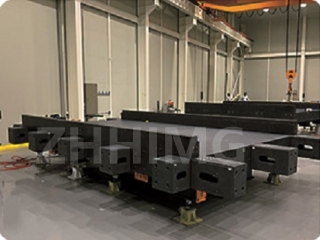Three-coordinate measuring machines (CMMs) are devices widely used across a range of manufacturing industries to measure the precise size, geometry, and location of complex 3D structures. The accuracy and reliability of these machines are critical for ensuring the quality of the final product, and one key factor that contributes to their performance is the core component that underlies the measurement process: the granite surface plate.
Granite is known for its exceptional physical properties, including its high stiffness, low coefficient of thermal expansion, and excellent damping capacity. These characteristics make it an ideal material for CMMs, which need a stable and rigid base to support their measuring probes and provide accurate and consistent data. In this article, we will explore the advantages of granite as the core component of CMMs and how it contributes to their performance.
1. Stiffness: Granite has a very high Young's modulus, which means it is highly resistant to deformation when subjected to mechanical stress. This stiffness ensures that the granite surface plate remains flat and stable under the weight of the sample or the measuring probe, preventing any unwanted deflections that could compromise the accuracy of the measurements. The high stiffness of granite also allows CMMs to be built with larger granite surface plates, which in turn provides more space for larger parts and more complex geometries.
2. Thermal stability: Granite has a very low coefficient of thermal expansion, which means it does not expand or contract much when exposed to changes in temperature. This property is essential for CMMs since any variations in the size of the surface plate due to temperature changes would produce errors in the measurements. Granite surface plates can provide stable and reliable measurements even in environments where temperature fluctuations are significant, such as factories or laboratories.
3. Damping capacity: Granite has a unique ability to absorb vibrations and prevent them from affecting the measurements. Vibrations can come from various sources like mechanical shocks, operating machinery, or human activity near the CMM. The damping capacity of granite helps to reduce the vibrations' impact and ensure that they don't create noise or measurement errors. This property is particularly crucial when dealing with very sensitive and delicate parts or when measuring at high accuracy levels.
4. Durability: Granite is a very tough and durable material that can withstand long-term use and abuse in industrial environments. It is resistant to scratches, corrosion, and wear and tear, making it an ideal choice for a component that must provide stable and accurate measurements over an extended period. Granite surface plates require minimal maintenance and can last for decades, providing a long-term investment in a CMM.
5. Easy to clean: Granite is very easy to clean and maintain, making it a practical choice for industrial applications. Its non-porous surface resists moisture and bacterial growth, reducing the risk of contamination and ensuring the integrity of the measurements. Granite surface plates can be cleaned quickly with water and soap and require little effort to keep them in good condition.
In conclusion, granite as the core component of CMMs provides significant advantages that contribute to their performance and reliability. The stiffness, thermal stability, damping capacity, durability, and ease of cleaning make granite an ideal choice for a component that must provide accurate and consistent measurements under different conditions. CMMs built with granite surface plates are more robust, more stable, and more accurate, providing the confidence and precision required to manufacture high-quality products.
Post time: Apr-09-2024

